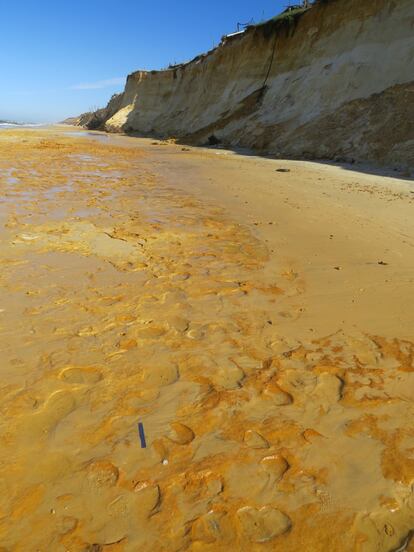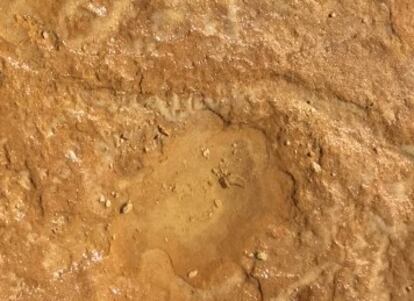How Neanderthals and giant animals walked side by side on Spain’s southern coast
An analysis of 106,000-year-old markings in Matalascañas allows scientists to reconstruct how the hominids hunted straight-tusked elephants for survival

Picture the scene on the Andalusian beach of Matalascañas in the Doñana nature reserve, 106,000 years ago. The beach was immense, up to six kilometers wide, and at the first signs of dawn, a small group of Neanderthals would appear to follow the trail of a herd of straight-tusked elephants, the last pachyderms in southern continental Europe. Fellow travelers might have included wolves, deer and 300-kilo wild boars, as well as aurochs, an extinct ancestor of modern-day cows that measured up to two meters in height, according to a new study published by Spanish scientists in Scientific Reports. This fascinating new research, the latest in a series of studies, shows Neanderthal footprints were imprinted alongside the tracks of elephants (Palaeoloxodon antiquus) with huge heads and straight tusks.
Elsewhere, herbivores would seek water and pasture in the lagoon areas between the dunes, which had not yet been shaped into the cliffs we see today and which are known as El Asperillo. Neanderthals and wolves would hunt in the open. “There are clear traces of three steps taken by an adult Neanderthal and on the same surface elephant tracks appear, some of them made by newborns. This relationship is very important,” said Fernando Muñiz, an ichnologist (someone who studies the traces left in fossil records), professor at the University of Seville and co-author of the research series.

These Neanderthals were neither the first nor the last. Some studies date the oldest remains in Eurasia to 400,000 years ago, and the most recent traces of this species belong to an adolescent who measured 1.30 meters tall, and who was found in a quarry in Gibraltar. His remains date back 28,300 years. But the new research helps us to understand the life of a unique coastal ecosystem, as well as Neanderthal diets, social structures and interactions with animals.
The Neanderthal footprints from Matalascañas were left around the same time as 34 other tracks of different straight-tusked elephants. Some of them reflect the passage of two females walking together behind their slower offspring. Of the younger specimens, footprints have been found that correspond to newborns and young calves, weighing between 70 and 200 kilos, and others of juveniles between eight and 15 years old. There are also isolated tracks of males indicating the presence of giant specimens that weighed up to seven tons.The presence of these tracks shows that the grass and freshwater reserves in the area aided elephants to reproduce, as their offspring were less able to travel long distances in search of these resources. This could have been fundamental for the presence of Neanderthals, according to Muñiz and Carlos Neto de Carvalho, a Portuguese geologist, paleontologist and researcher, since there are signs that the Neanderthals found the youngest elephants and some females to be easier prey and “a very rich source of proteins,” without ruling out the consumption of stillborn animals or mothers who died in childbirth.

This abundance of resources and the mild climate, similar to today’s, prevailed while in the rest of Europe Neanderthals survived in icy environments. This led them to settle in the area despite the absence of natural shelter. “It is important to emphasize that this is a site in a coastal area where they had no choice but to live in the open air. It is and was an open landscape because there have never been rocky outcrops or nearby formations with caves,” said Joaquín Rodríguez Vidal, a professor of geodynamics and geomorphology at the University of Huelva, and also a co-author of the studies.
The existence of traces of Neanderthal footprints confirmed by this team of researchers, as well as various animal species, are evidence of a stable presence of hominids in this coastal environment. Vidal believes that the set of different footprints shows the passage of several individuals, although he does not believe that it was a large group. “They were not like Homo sapiens, who lived in larger communities. Neanderthals used to form family groups and, possibly, that was one of the causes of their extinction, since they had to mix with each other: inbreeding and living in a small group brought them fewer advantages.”
Juan Manuel Jiménez Arenas, a researcher at the Department of Archeology of the University of Granada, and director of ProjectORCE, backs this up in a study published in Quaternary Science Reviews: “We [Homo sapiens] are a very gregarious species who must have lived in relatively large groups, possibly of more than 30 individuals. This gave us an important evolutionary advantage to tackle inbreeding (probably one of the factors that triggered the disappearance of the Neanderthals) and on the other hand, the presence of predators. Likewise, social cohesion would contribute to survival in a complex and conflictive environment.”
Tu suscripción se está usando en otro dispositivo
¿Quieres añadir otro usuario a tu suscripción?
Si continúas leyendo en este dispositivo, no se podrá leer en el otro.
FlechaTu suscripción se está usando en otro dispositivo y solo puedes acceder a EL PAÍS desde un dispositivo a la vez.
Si quieres compartir tu cuenta, cambia tu suscripción a la modalidad Premium, así podrás añadir otro usuario. Cada uno accederá con su propia cuenta de email, lo que os permitirá personalizar vuestra experiencia en EL PAÍS.
¿Tienes una suscripción de empresa? Accede aquí para contratar más cuentas.
En el caso de no saber quién está usando tu cuenta, te recomendamos cambiar tu contraseña aquí.
Si decides continuar compartiendo tu cuenta, este mensaje se mostrará en tu dispositivo y en el de la otra persona que está usando tu cuenta de forma indefinida, afectando a tu experiencia de lectura. Puedes consultar aquí los términos y condiciones de la suscripción digital.
More information
Archived In
Últimas noticias
Most viewed
- Sinaloa Cartel war is taking its toll on Los Chapitos
- Oona Chaplin: ‘I told James Cameron that I was living in a treehouse and starting a permaculture project with a friend’
- Reinhard Genzel, Nobel laureate in physics: ‘One-minute videos will never give you the truth’
- Why the price of coffee has skyrocketed: from Brazilian plantations to specialty coffee houses
- Silver prices are going crazy: This is what’s fueling the rally











































